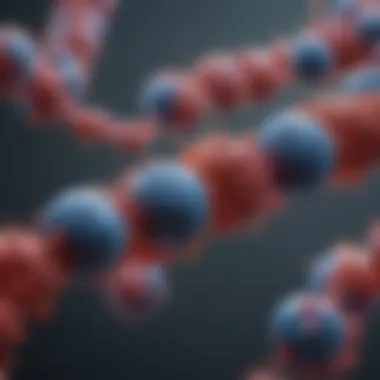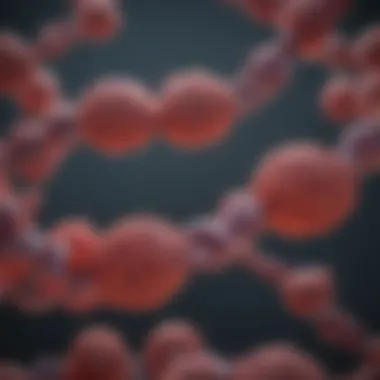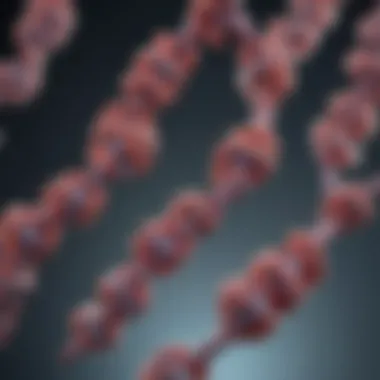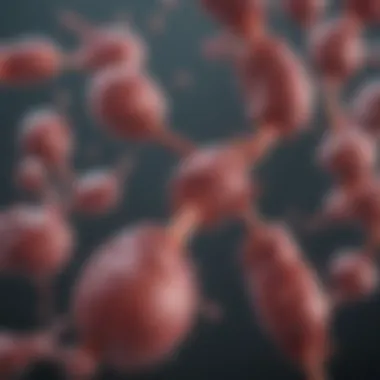Exploring J Chain Antibodies: Structure and Function


Intro
J chain antibodies, a fascinating component of the immune system, often get overshadowed by their more recognized counterparts in the immunoglobulin family. However, these antibodies hold pivotal roles in both systemic and mucosal immunity. As you delve deeper into this article, you will uncover how J chain antibodies contribute not only to immune defenses but also pose intriguing questions in clinical research.
Known for their unique structural composition, J chain antibodies, also identified as J chain-containing immunoglobulins, come equipped with significant biological properties. Their core purpose is to enhance the stability and transport of antibodies within mucosal environments, making them essential players in protecting mucosal surfaces against pathogens.
The intricate ballet of the immune response, where J chain antibodies interact with various immunoglobulin classes, forms the crux of their relevance. Far from being mere appendages, these chains play an integral role in orchestrating immune functions, ensuring that the body's defenses operate smoothly. Through this exploration, we aim to shine a light on their complexities, clinical significance, and implications for future research.
As you navigate this overview, you'll find an investigation into how J chain antibodies are linked to specific health conditions and the ongoing exploration of their potential therapeutic uses. It raises a vital question: are J chain antibodies the unsung heroes in immunology? Join us as we untangle the web of their structure and function, revealing their importance from foundational science to real-world application.
Intro to J Chain Antibodies
J chain antibodies play a pivotal role in the understanding of how our immune system operates. The presence or absence of these antibodies can shed light on various immunological processes, which make them a topic worth exploring. Their significance transcends basic immunology, touching upon areas such as clinical diagnostics and therapeutic applications. Understanding J chain antibodies provides insights into not just the workings of our own bodies but also potential avenues for enhancing health outcomes.
Definition and Overview
J chain antibodies, often referred to as J chain-containing immunoglobulins, are specialized structures found predominantly in secretory IgA and IgM. The unique aspect of these antibodies is the presence of a J chain polypeptide that assists in their polymerization. In essence, they allow certain immunoglobulins to form larger complexes which are crucial in various immune functions. These structures facilitate the transport of antibodies across epithelial barriers, contributing to mucosal immunity, particularly in gut health where a large portion of the immune system resides.
Understanding this aspect illuminates how our immune system uses these antibodies to ward off pathogens that enter through mucosal surfaces, making them indispensable in the fight against infection. The presence of the J chain enables the formation of secretory IgA that is particularly important for neutralizing pathogens before they can establish infections.
Historical Context
The journey of J chain antibodies is rooted in earlier discoveries around the structure and function of immunoglobulins. Researchers like D.M. Kahn carried out pioneering studies in the mid-20th century that led to the identification of J chains and their critical role in immunoglobulin assemblies. Initially, the understanding was rudimentary. At first, immunoglobulins were viewed singly without recognizing the need for additional subunits that assisted in collective functionality.
Over the years, as views on the immune system evolved, it became clear that the J chain was not just a mere accessory but a vital part of antibody functionality. Its involvement in forming large antibody complexes revealed deeper layers of immune mechanisms, expanding the field of immunology significantly. This evolutionary understanding in molecular biology reflects broader trends in scientific research, where initial observations can lead to transformative insight into complex biological processes.
Structural Characteristics of J Chain Antibodies
The structural characteristics of J chain antibodies are crucial to understanding their functionality within the immune system. J chain antibodies, specifically the immunoglobulin M (IgM) and immunoglobulin A (IgA) classes, derive their unique features from the presence of J chains, which significantly influence not just their structural integrity but also their interaction with other components of the immune response. Delving into these characteristics lends insight into how these antibodies perform their roles effectively.
Composition of J Chains
J chains are polypeptide units consisting of approximately 15 to 20 amino acids. While relatively small, they are pivotal in linking monomeric immunoglobulins into larger structures. Think of them as the glue binding different pieces of a puzzle, making sure that the resulting image maintains coherence and fits perfectly together. This linkage is essential for forming the pentameric structure of IgM and the dimeric form of IgA.
Here's a closer look at the composition:
- Basic Structure: The J chain is made up of a short chain of amino acids. Specific post-translational modifications can occur, but these changes do not stray too far from the overall simplistic structure.
- Dimension: Measuring around 15 kDa, they aren't bulky, allowing for flexibility in the antibody structure, which is often critical during immune responses.
- Functional Regions: The structure of the J chain includes regions essential for its binding affinity to the complement and other immunoglobulin components.
"Understanding the composition of J chains not only clarifies their role in structural integrity but also hints at their significance in immune system dynamics."
These factors contribute to the unique aspects of J chains in their respective immunoglobulin classes and allow for effective immunological responses in various environmental contexts, including mucosal surfaces.


Association with Immunoglobulin Classes
Another noteworthy aspect is the specific association of J chains with certain immunoglobulin classes. This association is selective, as it primarily ties itself to immunoglobulin M and A.
- Immunoglobulin M (IgM): This is the first antibody produced during an immune response. It typically forms a pentamer structure enhanced by five monomer units linked through J chains. In this case, the J chain acts as a bridge, enabling IgM to respond swiftly to pathogens.
- Immunoglobulin A (IgA): Unlike IgM, IgA usually exists as a dimer in secretions like saliva, breast milk, and tears. The J chain serves a similar role by linking its two monomer units, allowing for its optimal function in mucosal immunity.
Understanding these associations is central in immunology because they provide insight into the antibody's functionality and the body’s response to various pathogens.
Conformational Dynamics
The conformation of J chain antibodies is another critical facet to consider. Their structure is not static but rather dynamic, often changing in response to various stimuli. When discussing conformational dynamics, it’s essential to consider how the J chain can affect the overall shape and function of the immunoglobulins.
- Flexibility and Function: The presence of the J chain introduces a level of flexibility to the polymeric structures of IgA and IgM. This flexibility ensures that these antibodies can adapt to different scenarios presented by pathogens, potentially resulting in increased effectiveness during an immune response.
- Activation Mechanisms: Various agents can trigger conformational changes in J chain antibodies. When encountering an antigen, the antibodies may undergo structural reconfigurations, thereby enhancing their binding efficiency to that antigen. This feature can be likened to an athlete adjusting their technique during a competition, optimizing their approach for better results.
As you can see, the structural dynamics of J chain antibodies are integral to their role in immune responses. These characteristics allow them to maintain their function as key players in defending our bodies, ensuring we remain equipped against potential threats.
Biological Significance of J Chain Antibodies
Understanding the biological significance of J chain antibodies is essential because they play a pivotal role in the immune system, particularly in humoral immunity. These antibodies, being integral to the structure and function of immunoglobulins, are not just bystanders in the immune response but active players. As one delves into their various roles, the importance of J chain antibodies becomes apparent through their nuanced interactions and functions in different immunological processes.
Role in Immune Response
J chain antibodies contribute significantly to the immune response. They primarily function as linking structures in the formation of larger antibody complexes. This is particularly visible in the IgM and IgA immunoglobulin classes, which rely on J chains for their polymeric forms. When a pathogen invades the body, the presence of J chain antibodies enables these immunoglobulins to assemble effectively and mount a robust defense.
- Key Functions:
- Pentamer Formation: In the case of IgM, five IgM monomers bind together through J chains, forming a pentamer that is crucial for effective opsonization and agglutination of pathogens, enhancing their visibility to phagocytes.
- Class Switching Facilitation: J chains also aid in class switching during B cell activation, allowing for a more tailored immune response as the body encounters different pathogens.
The synergy between J chains and immunoglobulins represents an essential evolutionary adaptation, maximizing the efficiency of the immune system. Thus, it is through these intricate connections that J chain antibodies underscore their crucial role in maintaining homeostasis within the immune framework.
Functions in Mucosal Immunity
Mucosal immunity, which constitutes a significant part of the body’s defense system, heavily relies on J chain antibodies. Specifically, secretory IgA (sIgA) is formed in mucosal tissues and requires J chains for its stability and transport. These antibodies are found in bodily secretions such as saliva, tears, and mucous, where they serve as the first line of defense against pathogens entering through mucosal surfaces.
- Protective Mechanisms:
- Neutralization of Pathogens: sIgA prevents pathogens from adhering to epithelial cells, effectively neutralizing potential infections before they take root.
- Immune Exclusion: J chain antibodies play a role in immune exclusion, whereby sIgA can bind to antigens and prevent their translocation into the body, thus serving as a barrier.
In summary, the role of J chain antibodies in mucosal immunity emphasizes their essential protective strategies, ensuring that mucosal surfaces remain fortified against external biological threats.
Interaction with Antigen Presenting Cells
The dynamic between J chain antibodies and antigen presenting cells (APCs) reveals another layer to their biological significance. J chain antibodies enable a more effective communication network between B cells and APCs, crucial for initiating and nurturing the adaptive immune response.


- Mechanisms of Interaction:
- Facilitation of Antigen Presentation: Through binding with receptors on APCs, J chain antibodies can assist in the uptake of antigens, enhancing the likelihood of T cell activation and subsequent proliferation.
- Regulation of Immune Responses: The interaction with APCs can modulate the immune response, promoting either tolerance or activation based on the context of the signals received.
This interplay not only concludes that J chain antibodies are integral to the initiation of immune responses but also highlights their role in shaping the precision of immune reactions, maintaining balance within the immune system.
J chain antibodies are more than mere structural components; they are fundamental to orchestrating effective immune responses as well as modulating interactions at the mucosal level and with APCs.
Clinical Implications of J Chain Antibodies
The clinical implications of J chain antibodies are vast and multifaceted, touching on numerous aspects of immunology and healthcare. As a key player in the immune system, understanding how J chain antibodies function can provide insights into disease processes and therapeutic approaches. This section shines a light on three critical elements: their role in health and disease, detection techniques, and their implications in immunopathology. Each of these areas contributes to a holistic view of how J chain antibodies may inform both clinical practice and research advancements.
J Chains in Health and Disease
J chains are small polypeptides that form a crucial part of the immunoglobulin architecture, particularly IgM and IgA. Their presence is intertwined with the body's immune response capabilities. In a state of health, these antibodies help maintain mucosal immunity and regulate lymphocyte activation. However, alterations in J chain production or functionality can lead to a range of disorders.
For instance, an absence of J chain can be linked to increased susceptibility to infections, as seen in certain immunodeficiencies. On the flip side, excess or improperly functioning J chain antibodies may participate in the pathogenesis of autoimmune diseases, where the body mistakenly targets its own tissues.
"Understanding the delicate balance of J chain antibodies can potentially guide interventions that reinforce immune health or mitigate disease processes."
Key points to consider:
- Balance in function: Both deficiency and excess may lead to health issues.
- Associations with autoimmune conditions: Excessive J chain activity can correlate with diseases such as lupus or rheumatoid arthritis.
- Potential for diagnostic markers: Variations in J chain levels could serve as indicators for specific health conditions.
Detection Techniques
Detecting J chain antibodies is increasingly important for diagnosing and monitoring various health conditions. Various methods exist for their identification and quantification. Common techniques include:
- Enzyme-Linked Immunosorbent Assay (ELISA): This is often employed for its sensitivity and specificity.
- Western Blotting: Useful for confirming the presence of J chain antibodies when complex profiles are required.
- Flow Cytometry: Offers quantitative data on the expression of J chains on immune cells, providing insight into their role in immunity.
In each of these methods, the sensitivity of detection can significantly affect clinical outcomes. Accurately identifying J chain levels enables healthcare professionals to tailor treatment plans suited to individual patient needs.
Implications in Immunopathology
The implications of J chain antibodies in immunopathology are particularly noteworthy. These antibodies play a role in maintaining homeostasis within the immune system, and any disruption can lead to significant consequences.
Examples of immunopathological implications include:
- Chronic Inflammation: Overexpression of J chain antibodies can exacerbate inflammatory processes, leading to tissue damage.
- Cancer: J chains may influence tumor immunology; understanding their role could open new avenues for cancer therapeutics.
- Autoimmune Disorders: As noted earlier, dysregulation may participate in autoimmune pathologies, necessitating thorough investigation of J chain functions in these contexts.
In summary, the clinical implications of J chain antibodies are profound, providing a lens through which to view both health and disease. As research continues to evolve in this area, it will be crucial for clinicians and researchers alike to stay abreast of findings that could impact therapeutic strategies and diagnostic practices.
Research Advances Involving J Chain Antibodies


Research into J chain antibodies has gained traction in recent years, shedding light on their multifaceted roles within the immune system. Advancements in this field help illuminate various pathways and mechanisms that J chains engage in, which is particularly vital given their unique characteristics and the implications they hold for health and disease.
Current Studies and Findings
Numerous studies are underway, probing deeper into the mechanisms of action of J chain antibodies. One noteworthy area of investigation focuses on their interaction with different classes of immunoglobulins. Recent findings suggest that the presence of J chains enhances the stability of IgM and IgA molecules. For instance, a study published in the "Journal of Immunology" indicated that J chain antibodies confer additional functionality to these classes, enabling a more robust immune response.
Moreover, researchers are uncovering the role of J chain antibodies in the modulation of cellular signaling pathways. Certain investigations have revealed that these antibodies may influence the activity of cytokines, thereby affecting the nature and intensity of immune responses.
In addition, exploratory work has been directed towards understanding how J chain antibodies could potentially influence the gut microbiome. Given the significance of gut health in immunology, this line of inquiry could have broad implications for therapeutic strategies and disease prevention.
J Chain Antibodies and Vaccinology
As the medical field increasingly embraces the potential for vaccinology, the relevance of J chain antibodies becomes ever clearer. Their role in enhancing immune responses has led to discussions on how these antibodies can be utilized to develop more effective vaccines. For example, J chain antibodies are believed to improve the protective efficacy of mucosal vaccines. This is key in combating diseases that enter the body through mucosal surfaces, such as respiratory infections.
In recent experimental vaccines, researchers have incorporated elements of J chain antibodies to boost immunogenicity. A pilot study indicated that vaccines engineered with J chains could elicit stronger mucosal immunity than those without. Such findings point towards a potential shift in vaccine design, emphasizing the need to consider the interplay of various immunoglobulin classes and their structural components.
Future Directions in Research
Looking ahead, several promising avenues await exploration in the realm of J chain antibodies. One potential direction includes optimizing therapeutic interventions based on the immunological principles derived from J chains.
Further research could focus on their application in personalized medicine, particularly in designing tailored immunotherapies. Understanding how different individuals respond to J chain antibodies could lead to more effective treatments for autoimmune diseases and cancer.
Additionally, there's a need for more comprehensive studies on the genetic and environmental factors that influence the production and function of J chain antibodies. Such data could provide insights into why certain populations may exhibit varying immune responses, helping to refine strategies for public health interventions.
"Future research into J chain antibodies holds the key to unlocking new therapeutic horizons in immunology."
In summary, the field of J chain antibodies continues to evolve, with significant implications for both basic research and clinical applications. The ongoing studies not only aim to enhance our understanding of these structures but also position them at the forefront of future innovations in immunotherapy and vaccine development.
The End
The exploration of J chain antibodies sheds light on their multifaceted role within the immune system. As a linchpin in the orchestration of immune responses, these antibodies contribute significantly to both health and disease states. Their unique structural characteristics allow for intricate interactions with various immunoglobulin classes, enhancing both mucosal and systemic immune responses.
Summary of Key Points
In summarizing the key aspects discussed throughout the article, it is crucial to highlight the following points:
- Structural Importance: J chain antibodies are not just passive players; their structure is tailored to ensure optimal performance in immune surveillance.
- Role in Immune Function: These antibodies aid in transporting immunoglobulin across mucosal barriers, playing a vital role in pathogen defense and immune memory. Their activity is paramount, especially in conditions like respiratory infections where mucosal immunity is tested.
- Clinical Relevance: Understanding how J chain antibodies function provides insights into various immunopathologies. Their detection can aid in identifying underlying health issues, allowing for timely interventions.
- Research Directions: As the field of immunology evolves, current studies on J chain antibodies unveil potential avenues for therapeutic applications, including vaccine development and treatment strategies for autoimmune conditions.
By grasping the significance of J chain antibodies, it's evident they represent a critical component in the greater scheme of immunological responses. Their study not only enhances our understanding of immune functionality but also opens doors for innovative research and clinical applications. As we stand on the threshold of new discoveries, J chain antibodies remain a topic ripe for exploration and potential breakthroughs in immunological health.
Citations and Further Reading
Citing studies, articles, and relevant publications gives readers a pathway to explore the subject further. Here are several essential elements to consider when compiling references:
- Diversity of Sources: Mixing journal articles, books, and online resources can provide a well-rounded perspective on J chain antibodies. Engaging with both primary and secondary sources arms the reader with a thorough understanding.
- Current and Relevant Research: Given the rapid advances in immunology, utilizing fresh data and recent findings is critical. This not only keeps the information accurate but also highlights ongoing research trends and shifts in understanding.
- Credibility: References from reputable journals or established authors lend weight to your narrative. High-Q scholars often scrutinize the sources, so a robust list doesn’t just boost your article's academic credibility, it helps in building trust with the reader.
- Accessibility: Ensuring that your references lead to accessible resources is crucial. Links to platforms like Wikipedia, Britannica, or even specialized immunology blogs can bridge knowledge gaps for readers who may not have access to academic journals.
By including the right references, an article can become an authoritative resource for students, researchers, educators, and professionals interested in the intricate world of J chain antibodies.
"A strong reference section is like a compass in scientific writing; it guides readers to broader horizons of understanding."















